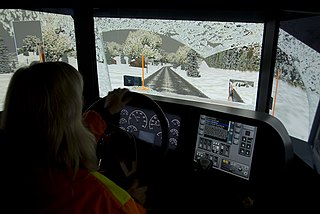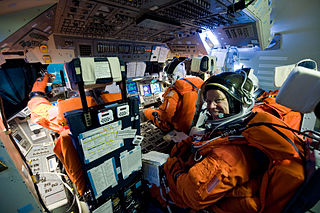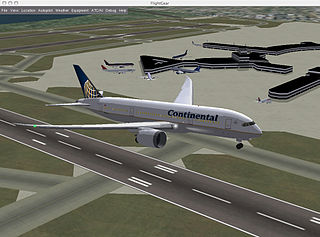
A simulation is an imitative representation of a process or system that could exist in the real world. In this broad sense, simulation can often be used interchangeably with model. Sometimes a clear distinction between the two terms is made, in which simulations require the use of models; the model represents the key characteristics or behaviors of the selected system or process, whereas the simulation represents the evolution of the model over time. Another way to distinguish between the terms is to define simulation as experimentation with the help of a model. This definition includes time-independent simulations. Often, computers are used to execute the simulation.

A flight simulator is a device that artificially re-creates aircraft flight and the environment in which it flies, for pilot training, design, or other purposes. It includes replicating the equations that govern how aircraft fly, how they react to applications of flight controls, the effects of other aircraft systems, and how the aircraft reacts to external factors such as air density, turbulence, wind shear, cloud, precipitation, etc. Flight simulation is used for a variety of reasons, including flight training, the design and development of the aircraft itself, and research into aircraft characteristics and control handling qualities.

Microsoft Flight Simulator is a series of flight simulator programs for MS-DOS, Classic Mac OS, and Microsoft Windows operating systems. It was an early product in the Microsoft application portfolio and differed significantly from Microsoft's other software, which was largely business-oriented. Microsoft Flight Simulator is Microsoft's longest-running software product line, predating Windows 1.0 by three years, and is one of the longest-running video game series of all time.
Aviation is the design, development, production, operation, and use of aircraft, especially heavier-than-air aircraft. Articles related to aviation include:

A Stewart platform is a type of parallel manipulator that has six prismatic actuators, commonly hydraulic jacks or electric linear actuators, attached in pairs to three positions on the platform's baseplate, crossing over to three mounting points on a top plate. All 12 connections are made via universal joints. Devices placed on the top plate can be moved in the six degrees of freedom in which it is possible for a freely-suspended body to move: three linear movements x, y, z, and the three rotations.

A simulation cockpit, simpit or sim rig is an environment designed to replicate a vehicle cockpit. Although many pits commonly designed around an aircraft cockpit, the term is equally valid for train, spacecraft or car projects.

CAE Inc. is a Canadian manufacturer of simulation technologies, modelling technologies and training services to airlines, aircraft manufacturers,and defence customers. CAE was founded in 1947, and has manufacturing operations and training facilities in 35 countries.

Driving simulators are used for entertainment as well as in training of driver's education courses taught in educational institutions and private businesses. They are also used for research purposes in the area of human factors and medical research, to monitor driver behavior, performance, and attention and in the car industry to design and evaluate new vehicles or new advanced driver assistance systems.
Combat flight simulators are vehicle simulation games, amateur flight simulation computer programs used to simulate military aircraft and their operations. These are distinct from dedicated flight simulators used for professional pilot and military flight training which consist of realistic physical recreations of the actual aircraft cockpit, often with a full-motion platform.

A motion simulator or motion platform is a mechanism that creates the feelings of being in a real motion environment. In a simulator, the movement is synchronised with a visual display of the outside world (OTW) scene. Motion platforms can provide movement in all of the six degrees of freedom (DOF) that can be experienced by an object that is free to move, such as an aircraft or spacecraft:. These are the three rotational degrees of freedom and three translational or linear degrees of freedom.

The Shuttle Training Aircraft (STA) is a former NASA training vehicle that duplicated the Space Shuttle's approach profile and handling qualities, allowing pilots to simulate Shuttle landings under controlled conditions before attempting the task on board the orbiter. The STA was also flown to assess weather conditions just prior to Space Shuttle launches and landings.
Precision Manuals Development Group is a commercial add-on aircraft developer for the Microsoft Flight Simulator, Lockheed Martin Prepar3D, and X-Plane series. The company was founded by Robert S. Randazzo, who stated that his ultimate goal was to develop the software to the point where it could be used by airlines and manufacturers to supplement pilot training. The company is based out of Las Vegas, Nevada but has several employees in countries such as Belgium, South Africa, and Canada. It has eight employees as of 2018, with a collection of beta testers which include multiple aviation professionals.

Shuttle Mission Simulator (SMS) was an umbrella term for three separate simulators for training Space Shuttle crews at the Johnson Space Center (JSC). The simulators were the MBS, the FBS, and the GNS.
Frasca International, Inc., is an American manufacturer of flight simulation training devices, with over 3000 training devices delivered in approximately 70 countries throughout the world. Based in Urbana, Illinois, Frasca International was founded in Champaign, Illinois in 1958 by Rudy Frasca. It is owned by FlightSafety International, a division of Berkshire Hathaway, following an acquisition in 2022.
Frasca flight simulators are used in all segments of the aviation industry, including their extensive use in many prominent college aviation programs, including Purdue University, Indiana State University, Embry-Riddle Aeronautical University, University of North Dakota, Liberty University, Louisiana Tech University, University of Illinois, and Western Michigan University.

Acceleration onset cueing is a term for the cueing principle used by a simulator motion platform.

A flight simulation video game refers to the simulation of various aspects of flight or the flight environment for purposes other than flight training or aircraft development. A significant community of simulation enthusiasts is supported by several commercial software packages, as well as commercial and homebuilt hardware. Open-source software that is used by the aerospace industry like FlightGear, whose flight dynamics engine (JSBSim) is used in a 2015 NASA benchmark to judge new simulation code to space industry standards, is also available for private use. A popular type of flight simulators video games are combat flight simulators, which simulate combat air operations from the pilot and crew's point of view. Combat flight simulation titles are more numerous than civilian flight simulators due to variety of subject matter available and market demand.
Unmanned aircraft system simulation focuses on training pilots to control an unmanned aircraft or its payload from a control station. Flight simulation involves a device that artificially re-creates aircraft flight and the environment in which it flies for pilot training, design, or other purposes. It includes replicating the equations that govern how aircraft fly, how they react to applications of flight controls, the effects of other aircraft systems, and how the aircraft reacts to external factors such as air density, turbulence, wind shear, cloud, precipitation, etc.

A full motion racing simulator, sometimes called a full motion sim rig, is a motion simulator that is purposed for racing, and must provide motion simulation in all six degrees of freedom, as defined by the aviation simulator industry many decades ago. The six degrees of freedom coincide with Earth physics, and are commonly referred to as:

The 2016 Bell 525 Relentless prototype crash occurred during a test flight on July 6, 2016, near Italy, Texas, destroying the prototype Bell 525 Relentless helicopter and killing the two occupants. The helicopter broke up in flight while traveling about 229 mph (199 kn) at an altitude of about 2,000 feet (610 m); the main rotor contacted and severed the tail boom due to severe vertical oscillations. The crew were performing one engine inoperative (OEI) recovery testing; the test induced a scissors-mode vibration in the main rotor, which resulted in involuntary collective control input. The unintended biomechanical feedback loop exacerbated the vibration, until the rotor contacted the tail-boom.

A cross-cockpit collimated display (CCCD) is a display system used in full flight simulators (FFS) to provide the crew with a high-fidelity out-the-window (OTW) view of the simulated environment around the aircraft. It is called cross-cockpit collimated because the light from a projected distant object is composed of rays that remain parallel or near-parallel across the cockpit. Therefore, the projected object appears to both pilots to be realistically located in the distance, where the real object would be.















